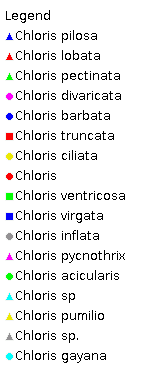Chloris Prodr. 1, 25 (1788).
Derivation:. From Greek chloros (green), possibly alluding to the greenish flowers and green leaves; alternatively, named for Chloris (The Green One), mythological Greek goddess of flowers.
Taxonomic revisions, nomenclatural references:. M.Lazarides, Austr. J. Bot. Supp. Ser. 5: 3–23 (1972); D.E.Anderson, Brigham Young Univ. Sci. Bull. Biol. Ser. 19:1–133 (1974); S.W.L.Jacobs and J.Highet, Telopea 3: 217–222 (1988).
Key references (keys and floras):. G.Bentham, Flora Australiensis 7: 610–614 (1878); C.A.Gardner, Flora of Western Australia 1 Gramineae 216–222 (1952); E.E.Henty, Manual Grasses New Guinea 47, 50 (1969); M.Lazarides, Tropical Grasses S.E.Asia 157–158 (1980); M.Lazarides, Flora of Central Australia 464–465 (1981); J.C.Tothill and J.B.Hacker, Grasses of Southern Queensland 154–158 (1983); J.P.Jessop, Flora of South Australia 4: 1950–1953 (1986); M.Lazarides, F.Quinn and J.Palmer, Flora of the Kimberley Region 1138–1140 (1992); B.K.Simon, Key to Australian Grasses 84–85 (1993); S.W.L.Jacobs and S.M.Hastings, Flora of New South Wales 4: 517–519(1993); N.G.Walsh, Flora of Victoria 2: 574–576 (1994); E.Edgar and H.E.Connor, Flora of New Zealand 5: 507–510 (2000); D.Sharp and B.K.Simon, AusGrass (2002); K.Mallet (ed.), Flora of Australia 44B: Poaceae 3: 269–282 (2005); J.P.Jessop, Grasses of South Australia 343–346 (2006); S.W.L.Jacobs, R.D.B.Whalley & D.J.B.Wheeler, Grasses of New South Wales, 4th Ed, 182–185 (2008).
W.D.Clayton & S.A.Renvoize, Genera Graminum (1986), genus (391).
Native and naturalised. About 55 species, from tropical and warm temperate regions. 11 species in Australia, WA, NT, SA, Qld, NSW, and Vic. Also New Guinea, Malesia and New Zealand.
Habit. Annual or perennial, rhizomatous or stoloniferous or tufted or decumbent. Leaf blades narrow. Ligule a fringed membrane to a fringe of hairs.
Inflorescence. Inflorescence of spicate main branches (rarely a single raceme), of digitate or subdigitate racemes or spikes, digitate or subdigitate (with spikelets on one side of axis).
Spikelets. Spikelets laterally compressed, more than 2 flowered, with 1 fertile floret (rarely 2), solitary or paired, subsessile or pedicelled; with naked rachilla extension. Fertile spikelets adaxial (with lower glume against rachis), disarticulating above glumes (the glumes usually persistent).
Glumes. Glumes unequal (divergent), (the longer) usually shorter than adjacent lemmas, pointed (acute or acuminate), awnless, similar to dissimilar (narrow, membranous, or the lower sometimes subulate). Lower glume 1 nerved. Upper glume 1–4 nerved.
Florets. Fertile florets 1 (rarely 2). Lemmas similar in texture to glumes to decidedly firmer than glumes (membranous or cartilaginous), not becoming indurated, entire at apex (truncate) or incised, awned, without a germination flap, 1–7 nerved, hairy (at the margins, often decoratively) or glabrous, 1 keeled. Awns 1 (usually) or 3, the median similar in form to laterals (when laterals present), from a sinus or apical, non-geniculate. Palea relatively long, entire to apically notched, 2 nerved. Distal incomplete florets 2–5, underdeveloped. Callus short, blunt. Lodicules 2. Stamens 3. Grain small, ellipsoid (to lanceolate), shallowly longitudinally grooved or not grooved, sub terete or trigonous. Hilum short. Embryo large (1/2 to 2/3 the grain length).
Kranz Anatomy. C4, biochemical type PCK (6 species).
2n = 14, 20, 26, 30, 36, 40, 72, 80, and 100, 2, 3, 4, 5, 8, and 10 ploid, commonly adventive.
Habitat. Mesophytic, xerophytic. Diverse habitats, mostly in short grassland on poor soil or disturbed ground. Species of open habitats.
Classification. Chloridoideae; Cynodonteae.
Notes. Several species clusters can be recognised, but there are too many minor clusters and isolated species for formal subdivisions to be of much practical value (Clayton and Renvoize, 1986).
Types Species. C. cruciata (L.)Sw.
Biogeographic Element. Clifford & Simon 1981, Simon & Jacobs 1990: Gondwanan.


